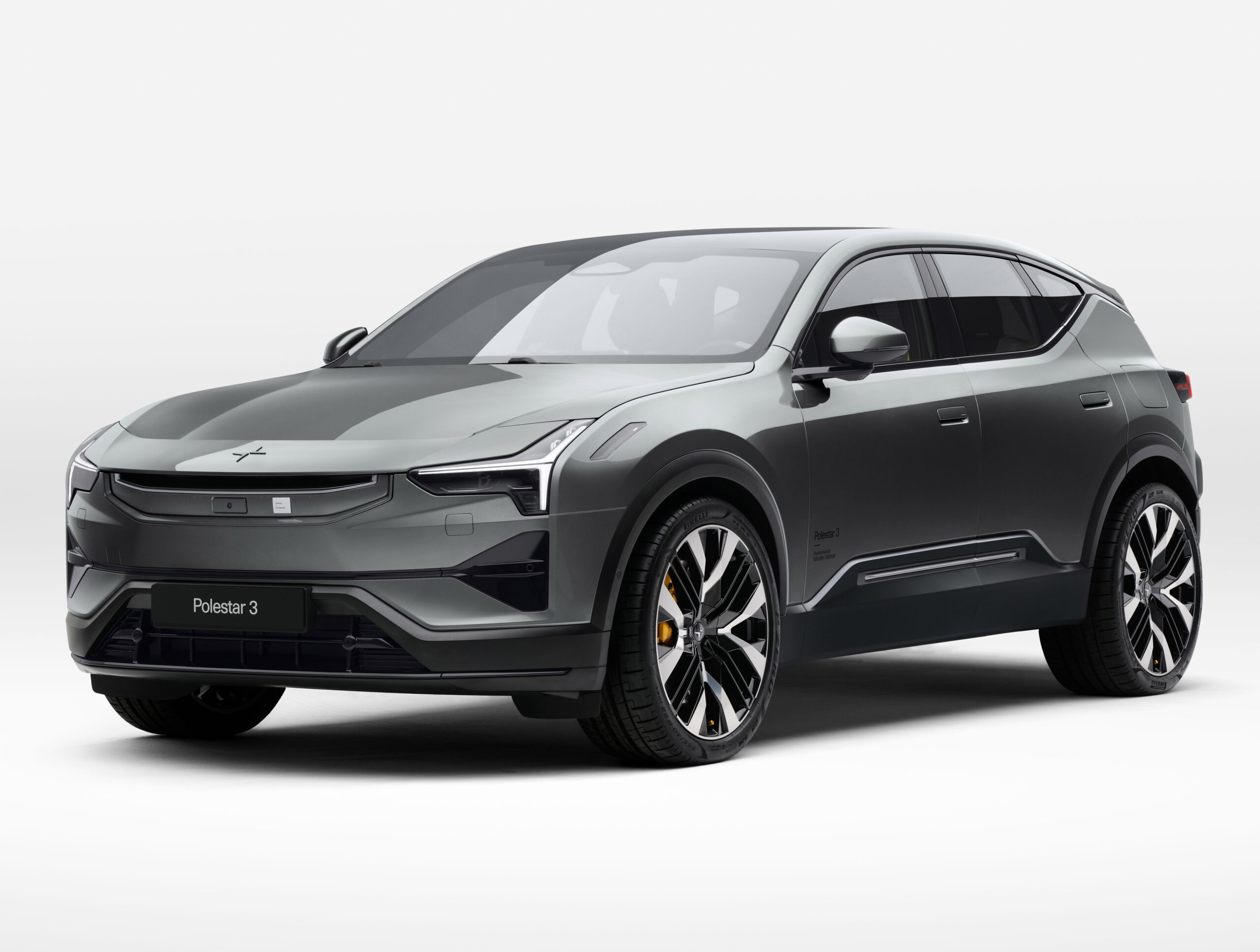

Lexus’ first ground-up electric vehicle is here, and it’s coming out……well, swinging might not be the best word. It’s a Lexus, so comfortable, subjectively attractive and filled with new safety and tech features, but it lacks the impressive range found on a few key competitors. The best you can get out of it is about 220 miles, though the majority of models with bigger wheels will max out below 200. Does the rest of the RZ package make up for that?
Based on the e-TNGA platform that underpins the Toyota bZ4X and Subaru Solterra, the RZ clearly maintains the body shape and size of those vehicles while looking strictly Lexus-like. Park this next to the brand-new RX, you might have a tough time discerning between the two right away. The RZ has a lower roofline and available two-tone paint options, as well as a large and black-painted C-pillar that lacks any daylight opening. This is a new design element for Lexus that we will also see implemented on the upcoming TX three-row crossover.
The Lexus ‘Spindle Body’ design theme is brought over from the new RX, meaning the grille area is more flush with the body instead of having a chrome border. The optional two-tone paint (only on the top trim) makes the grille portion black and carries that over the hood, a-pillars and roof. Unlike the Toyota Crown, Lexus does not carry the black onto the tailgate as well.

The wheels you choose on your RZ will drastically change your maximum range figure. In fact, because of this, Lexus product planners structured the trim hierarchy to be based around wheel size. 18-inch wheels are the standard size, while the trim with the 20″ wheels costs the most and gives you the least amount of range – 196 miles.
The rear end of the RZ is, in our opinion, its best angle. The horizontal light bar and Cadillac Lyriq-esque side fenders give it a sporty and modern appearance. The Lexus name is spelled out like the rest of the latest in the lineup, and it shares the separated spoiler elements from the Toyota and Subaru (standard here). The glass is aggressively angled, giving Lexus (and others) the misguided belief that owners will be okay without a rear wiper. Nevertheless, we still wish it had one.

Inside, the RZ is similar, but not quite identical, to the new RX. Toyota/Lexus’ new Audio Multimedia system anchors the large (and standard) 14-inch touchscreen, which is tied to a ton of subscription services. Want the ‘Hey Lexus’ voice-activation or built-in navigation? You’ll have to start paying a subscription after a year. Otherwise, the interior is covered in solid materials, but like Lexus’ newest generation of vehicles, has an ostensible lack of wood. This is definitely an interior tailored at the tech-forward crown, not the traditional Lexus buyer.
There is a healthy amount of standard equipment to be found in here, such as the 360-degree surround view camera, wireless Apple CarPlay and Android Auto, a wireless phone charger, a heated steering wheel, heated and ventilated front seats, and Lexus Safety System+ 3.0. That includes the new Proactive Driving Assist, a feature which acts like a gentle driving instructor who makes feather-light corrections for you on the road.

The only true disappointment with the interior is a disappointment it shares with other new Lexus models like the LX, RX and NX. The instrument cluster’s LCD display is on the small side for a car that Lexus claims is aimed at a younger more tech-savvy audience. While it may be only about 7″ in size, the optional head-up display makes up for it with a healthy 10″ of real estate.

From a 30,000-foot perspective, Lexus’ new steer-by-wire-based steering wheel (available only on the top Luxury trim) may appear to be a copy of the Tesla Yoke. That couldn’t be further from the truth. Not only does Lexus give the RZ’s equipped with this wheel a redesigned instrument cluster to better integrate the design, the variable ratio setup is much more appropriate. Here, the ratio is super quick, only requiring about one-and-a-half turns lock-to-lock, but it also adjusts based on your speed.
At slower parking lot speeds, you quickly figure out how much effort each size of turn requires of you, but what takes a little longer to master is the return to center. If your hands aren’t active and nuanced during the wheel’s return to center when coming out of a turn, it can sometimes feel like center has a large magnet attracting the wheel back to center in a rapid, jerky way. Higher speeds bring the best out of this system. If you are on a typical city road, the wheel barely asked for much in terms of input. You can use one finger to lane change, but taking sharper turns forces you to commit to a 10-and-2 hand position. But it becomes quite effortless on sweeping turns and angles larger than 90-degree.
The experience split opinions drastically. Brian said he would pay the extra cost (not confirmed yet but presumed to be anywhere between $2k-$5k) to get the feature, but Alex believes it answers a question no one asked. The question he wants answered is: who is this for, exactly?
At launch, Lexus is only offering one battery size and output. The 450e’s dual-motor setup uses the same building blocks found in the bZ4X and Solterra, which also ride on this e-TNGA platform. Here, however, Lexus uses a 201-horsepower electric motor up front and a 170-horsepower motor in the rear, for total (in the U.S.) of 308 horsepower. The battery is a 71.4-kWh hour pack that’s built by a Toyota-Panasonic joint venture in Japan (so no tax credit here is you purchase one). This pack is capable of faster charging than you’ll find in the dual-motor bZ4X in the U.S. – 150 kilowatts peak. According to Lexus, that should be enough power to get this battery from 0% to 80% in 30 minutes. While not terribly sub-par for the segment, the total range figure might give pause. The most available on the RZ is 220 miles. If you get the 20-inch wheels, that drops down to 196 miles. Also a little unusual is the onboard AC charger, which is only rated for 6.6 kilowatts. That is certainly on the slow side compared to the 10 and 11 kilowatt charges you’ll find on a majority of the competition.
Though we couldn’t test acceleration and braking at the drive event, Lexus says the RZ will do the 60 mph run in 5 seconds flat, and we concur with that based on initial feel. While that is faster than the dual-motor bZ4X, it’s not a massive jump. The Genesis Electrified GV70 will likely do the run a little quicker, but we are driving that soon after the RZ so you’ll know soon enough.
The first thing you notice out on the road is that the RZ has significantly more power than the related bZ4X. This is really obvious if you come to a stop and just floor it, 0-60 mph should happen in about five seconds flat. There are some augmented speaker sounds that come through more prominently in Sport mode, but acceleration doesn’t improve in that mode. Genesis electric vehicles like the GV60 will be faster, but unlike some of the competition, Lexus has decided to give us a more powerful electric motor up front than in the rear. That creates situations around corners where you’ll feel the steering wheel tug a bit more than you might in the competition. Thankfully, it’s not as obvious as it is in a Lexus plug-in hybrid or regular hybrid. Lexus has decided to give this fairly wide tires, 255 mm-wide tires out back, 235 mm up front.
We suspect the RZ is able to brake from 60 mph in around 120 feet. The brake feel here is much better than in Lexus hybrids, though the pedal actuation is a little light. Luckily, there’s no noticeable switch between regen and friction braking, something brands like Tesla do not believe in at all. They will only rely on friction brakes. When it comes to handling, it comes across as very well-sorted, but the suspension is a little bit firmer than we had expected. It’s not typical for a Lexus product, nor is the audible experience. Since this is the brand’s first dedicated EV, you hear a little bit more of the outside environment because there isn’t a buttery-smooth V6 engine to muffle and cover those sounds. The run-flat tires are also generally louder than the average tire. Lexus has done a really good job, however, at blending priorities. This feels so nice and stable out on a winding road even though it has significantly more ground clearance than an EV6 or a Tesla Model Y, though it’s not quite as high up as the bZ4X and Solterra.
The Eco and Range drive modes might actually be more interesting than Sport. Eco adapts the climate control and accessories for more economic operation range. Range mode makes the car become a predominantly rear-wheel-drive EV. Though Lexus mainly disables the front electric motor in this mode, they don’t mechanically disconnect it. You should be able to squeeze as much as 225 miles of range out of the RZ, a more conservative number compared to other existing competitors. You will notice that the vast majority of EV designs generally focus regenerative braking on the front electric motor, so it’s surprising that they didn’t use the front motor rather than the rear in Range mode. Regen can be adjusted via the paddles on the wheel, but there no one-pedal drive mode. Independent studies and some EV manufacturers agree that aggressive throttle lift-off regeneration and one-pedal driving can actually reduce your overall efficiency, especially if you’re driving on a winding road. It’s worth noting that this battery may be about 72-kWh in capacity, but the usable capacity is only about 64-kWh. They’re really sheltering it for a more extended lifetime, which should mean that you can much more easily and more consistently charge it to 100%, something you shouldn’t do in a Tesla or Rivian.
The RZ makes a solid case that electric powertrains are the perfect match for luxury vehicles, especially Lexuses. It’s smooth, quiet and refined. If you’re living in an area where you’re worried about clearance for snow or tree branches, the RZ might give you a little bit of extra peace of mind thanks to its competitive ground clearance. There is also a heat pump system on board here, so owners will experience more efficient heating for the cabin in wintery climates. If you’re looking for more capability than this, the choices right now really are just the Rivian R1S and the Jaguar i-Pace. Lexus has done their best to adhere the RZ to the brand’s strict standards of reliability and dependability. That should be enough to keep laggard Lexus shoppers coming back, while innovators might even be lured in by the cutting-edge and intuitive steer-by-wire system. Do enough of those shoppers want to drive a Lexus, though? Only time will tell.
The RZ is hitting dealer lots now, though don’t expect to see too many in inventory for at least the first year. Only 5,000 are coming to America, with only two flavors to choose from. $59,650 will get you the 220-mile Premium trim with the 18″ wheels, which does have the ability to add features from the Luxury trim, while the Luxury trim comes fully loaded (though there are optional chrome wheels and other accessories) with 196 miles of range and 20″ wheels for $65,150.



